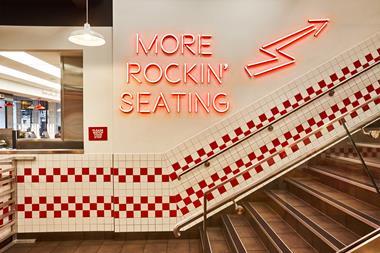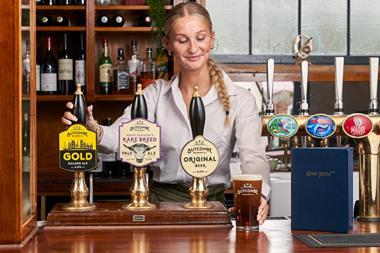Increasing costs are a fact of life for businesses and those that ride the changes well often remain successful. Stonegate Pub Company’s Dave Ross explains how investigating productivity has helped balance the books.
Whether it’s rising rents, food costs or wage inflation, there are always cost challenges confronting hospitality businesses. And whatever your view on the justification of the national living wage – and its possible impact on hospitality employers and jobs – the focus is the same as always, for any cost hurdle: to absorb it with as little impact on profit, and growth plans, as possible.
For Stonegate, it comes at an interesting time for our company, given our current focus on people, labour and productivity.
Formed in 2010 by TDR Capital with the acquisition of more than 300 pubs, our estate now comprises more than 600 sites and a clutch of brands including Slug & Lettuce. When we started out as a new company, we enjoyed the relative luxury of building much of our support infrastructure from scratch, and therefore were able to adopt some great management systems, ways of working and practices. This opportunity has driven profitability and delivered some big wins. However, five years in, much of this work has been done. We are now at a stage where, candidly, it’s getting harder to keep moving the dial so dramatically: the big opportunities are less apparent. Consequently, as a business, we have had to look further under the Stonegate bonnet to find those significant profit opportunities that don’t impact the guest experience. Or if they do, the ones that impact in a very positive way.
Like many businesses, in this industry and beyond, Stonegate has been looking at the issue of productivity. At a group level it’s about how we drive output, revenue and profit per employee; at a site level it’s about finding more sophisticated ways to ensure we have the right people deployed at the right location, working at the right time. For something that sounds so simple it’s a complex challenge, particularly in the land of multiple-site leisure.
A significant opportunity
However, armed with the conviction that productivity was a significant opportunity, it has in the past six months evolved into a major project at Stonegate – and will continue to be a focus for our business for the foreseeable future.
One of the key building blocks in the productivity journey is software. The systems now available in the market can do much of the heavy lifting, and having reviewed potential providers, we elected to partner with Fourth – cloud-based cost control solutions specialists.
While we believed we could make savings, the message to our operators was clear: we are not necessarily wedded to the idea of spending less on labour, we want to spend better. We wanted to drive a focus on recognising labour hours as a valuable resource and deploy them more effectively.
Forecasting is a science
In order to spend better, and to control our labour and drive productivity, we had to close the gap between our sales forecast and our actual sales delivered. Therefore we need to find a way of delivering acutely accurate revenue forecasts: what we expect to take at each site in the next sales period. When we started this project, there was a huge variance between sites in their ability to forecast accurately – some GMs were brilliant; some needed more guidance.
The way we now forecast is a two-stage process. Firstly, an algorithm within the productivity software is applied to an analysis of not just sales on the same day the previous week, month and year, but also a whole gambit of other information: the weather; local and national events (a festival, a football match or Mother’s Day); any idiosyncrasies, such as pay day (which increasingly has an impact not just on drinking occasions but dining too). Stage two sees the produced forecast, which predicts sales by 15-minute trading periods across the trading week, reviewed and revised by the GM, who is, of course, privy to further local information and site specifics that the software cannot possibly catch.
Armed with an accurate forecast, the next step is to apply labour ‘rules’. Put simply, these rules help to build a picture of the number of labour hours required to deliver those forecasted sales, based on the type of business or the operating model of a specific venue, the associated sales split, and service style and so on. Developing the rules was a major piece of work and another area where we leaned heavily on Fourth. Within the Stone-gate business, six different models, or sets of rules, emerged but importantly there has to be some flexibility to accommodate local variances and site-specific situations.
Based on these rules, the system suggests how many people should be scheduled for front of house and back of house, split down to 15-minute intervals. This process served to emphasise the less refined nature of our previous approach to scheduling, with people typically starting their shifts before we expected the venue to be busy and continuing after trade had tapered off. In simple terms there was not a close enough correlation between our sales line and our labour line. Our focus on productivity has helped us to get far closer to the two lines mirroring each other through the day parts. What was also noticeable was that the majority of our people started their shifts on the hour – for no other reason than that was how it had always been, despite the fact that these are hospitality venues, not offices. Now it’s not uncommon for people to start their shift at 9.45am or 5.15pm; just before we expect sales to rise.
Importantly, this focus on productivity was not about cutting labour hours, but redeploying them. Of course, we expected to make some savings to labour spend through better and smarter allocation of hours but we also expected to be able to drive top-line revenues by having more people on service at the right times, so that we can maximise our take during the really busy trading periods, such as evenings and weekends.
The people business
As ever, the most important aspect of this journey has been to win the hearts and minds of our operators. Clearly, ivory tower-based accountants need to take special care when talking to operators about ‘labour hours as a resource’ and ‘labour rules’. In our eagerness to implement, we were in danger of overlooking the absolute executional imperative of bringing people with us. We identified project champions throughout the business and ensured one-to-one time with every one of our 40 area managers.
A key message to our operators was that the forecast produced by the algorithm is a guide. And the site rules for labour are also there to guide. We expect to see a level of conformity – between the software forecast and the actual forecast and associated labour – of around 80%. If it rises much above 80% then the GM is following the system too rigidly; if it drops much below, then the system is not being followed closely enough.
The bottom line?
Candidly, we still have a small minority of people to bring with us, but most can see the tangible benefits, as the results of this project hit the P&L. And the absolute fact is that our P&L is now in better shape as a result of this journey.
We are going for a big number with this and believe that through a combination of some saved hours and also some redeployed hours (to drive sales) we will reduce our labour spend as a percentage of sales, by a full 1%. That feels pretty productive.
Dave Ross is chief financial officer at Stonegate Pub Company






























